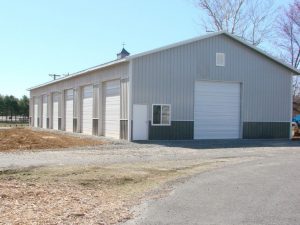Is Mini-Storage for You?
My brother and I were pole building contractors in 1991, when we got a contract to construct 3 self-storage buildings along rural Highway 95 just north of Athol, Idaho. We’d done other work for the same client, and had met with the property owner, who was providing the financing for the project. As luck would have it, just as we completed the third building, the financing collapsed and we ended up as the default owners of the property and the buildings. I learned a lot from being the “I don’t want to own it” owner.
In this particular project, the client had specified the unit mix – 100 units all 10’ x 20’. If I was going to do it all over again, I’d start with a single building 40’ x 100’ with either (20) 10’ x 20’ units, or (18) 10’ x 20’ and eight 10’ x 10’ units. In my case, it took a year to get 100 units to 50% occupancy. At 20 units, we could have filled before we opened the doors.
 Once the first building was filled, we could have monitored requests for other unit sizes. By gradual growth, fill one, then build another, a hundred units probably would have been filled in a year, rather than just half. Being fairly close to the south end of Lake Pend Oreille, we could have expanded to 10’ x 25’ units, which will accommodate most pleasure boats, and then grown to units for larger boats and recreational vehicles.
Once the first building was filled, we could have monitored requests for other unit sizes. By gradual growth, fill one, then build another, a hundred units probably would have been filled in a year, rather than just half. Being fairly close to the south end of Lake Pend Oreille, we could have expanded to 10’ x 25’ units, which will accommodate most pleasure boats, and then grown to units for larger boats and recreational vehicles.
While I thought getting into mini-storage units, in 1991, was “too late”, I did discover this not to be the case. In more recent years the climate has changed. Anything commercial has declined – maybe it is the financing and maybe it’s because people are leery of going to the bank.
Most mini-storage owners are repeat clients; they own one or more buildings and are increasing the size of their complex. The majority of mini-storages are in communities with populations of fewer than 15,000 people. Starting with 20 units with room for expansion seems to be a recipe for success.
Units in more populated areas can be smaller; however there is no real advantage to units which are 5 feet x 5 feet or 5 feet x 10 feet unless it is conveniently located in a larger city. If your units are out of town, like mine were, smaller units are generally not worth it. There are more defaults on smaller units than larger units. With the big units, they have a lot more to lose.
A customer also is not likely to go extra distance for the few dollars a month they might save in rent. If they’re renting a small unit for $20 a month, they’re not going to travel farther to save $3 a month. But if they can save $15 a month by driving out to the country, they’ll do it.
If you do plan to build, here are additional observations and suggestions:
Have a maintenance program and follow up on things. Most of your maintenance issues will be parking lots, driveways and electrical lights.
Accept theft is part of the business but be proactive with deterrents. You’ll have people cutting doors and tearing doors off. You’ll have an ex-spouse breaking in; they don’t have the combination to the lock or key, so they might take a chain and pull the door off. All the good stuff comes with it.
Don’t be tempted to spend money on all steel buildings, when a pole building will do everything you need it to do. The building absolutely has to have a well-sealed vapor barrier under the concrete slabs, and reflective roof insulation to prevent condensation drippage.
Map out your property. Know what you’ve got and know where your expansion area is, otherwise you waste a lot of square footage. When lots are too tightly packed there is a lot of damage to the doors. The more land you waste the more yearly income you waste. But if the customer can’t get in or they can’t get out, they won’t come back.
Mini-storage can be a nice secondary income. If you’re an existing business, this is a nice add-on, especially if you’re close to your existing business.
I had lots of people ask me if mini-storage is a pretty good business. The answer is: it’s a business. It’s like any other business: it’s as good as you can make it or it’s absolutely as tough as any other business. You have headaches, you have repossessions, you have deadbeats, and you have all the stuff which goes with a business. And there is no such thing as “easy money”. But with careful planning, starting small and leaving room for expansion, along with taking necessary precautions, it can be a well-earned “milk check” you’ve been looking for.






